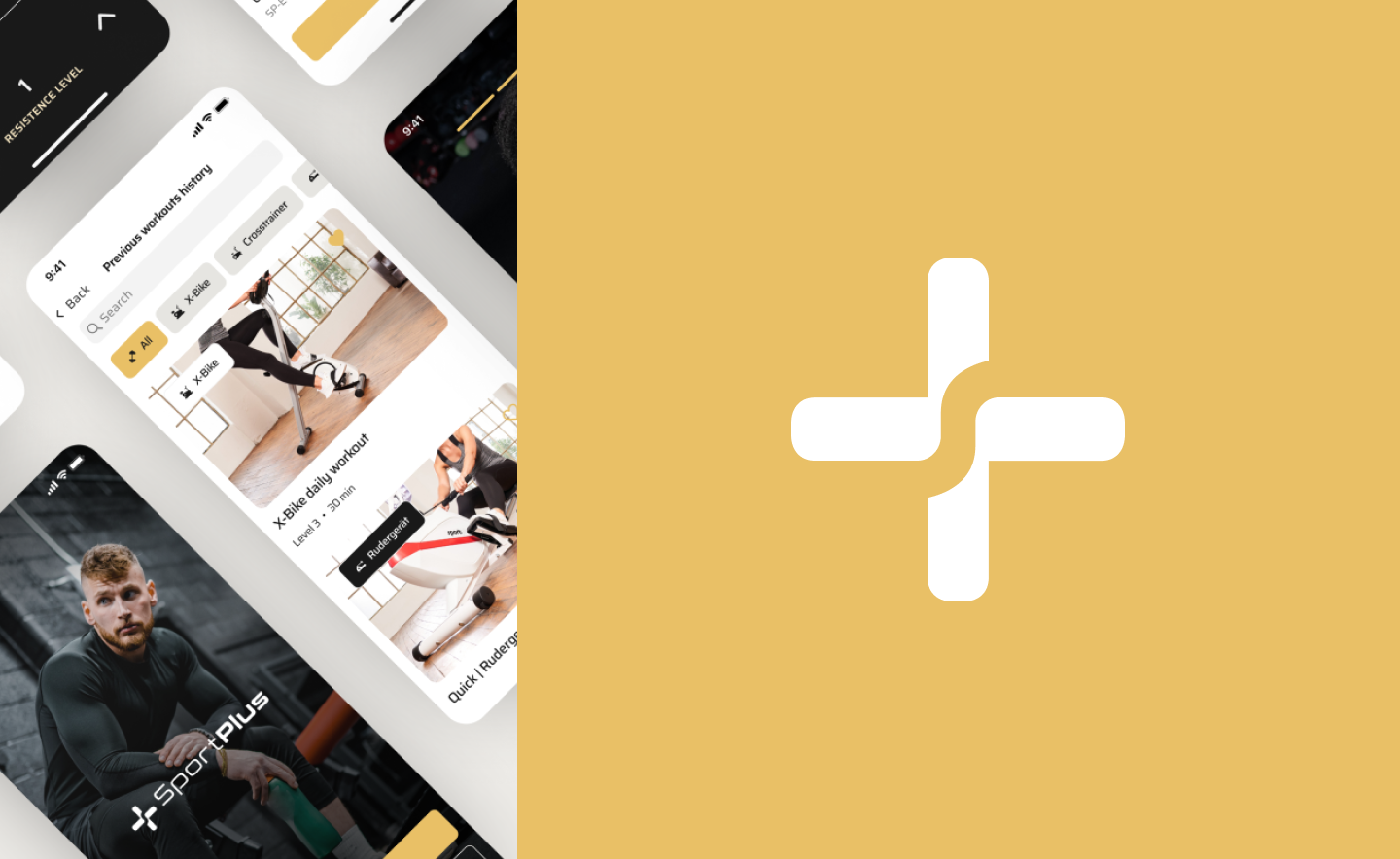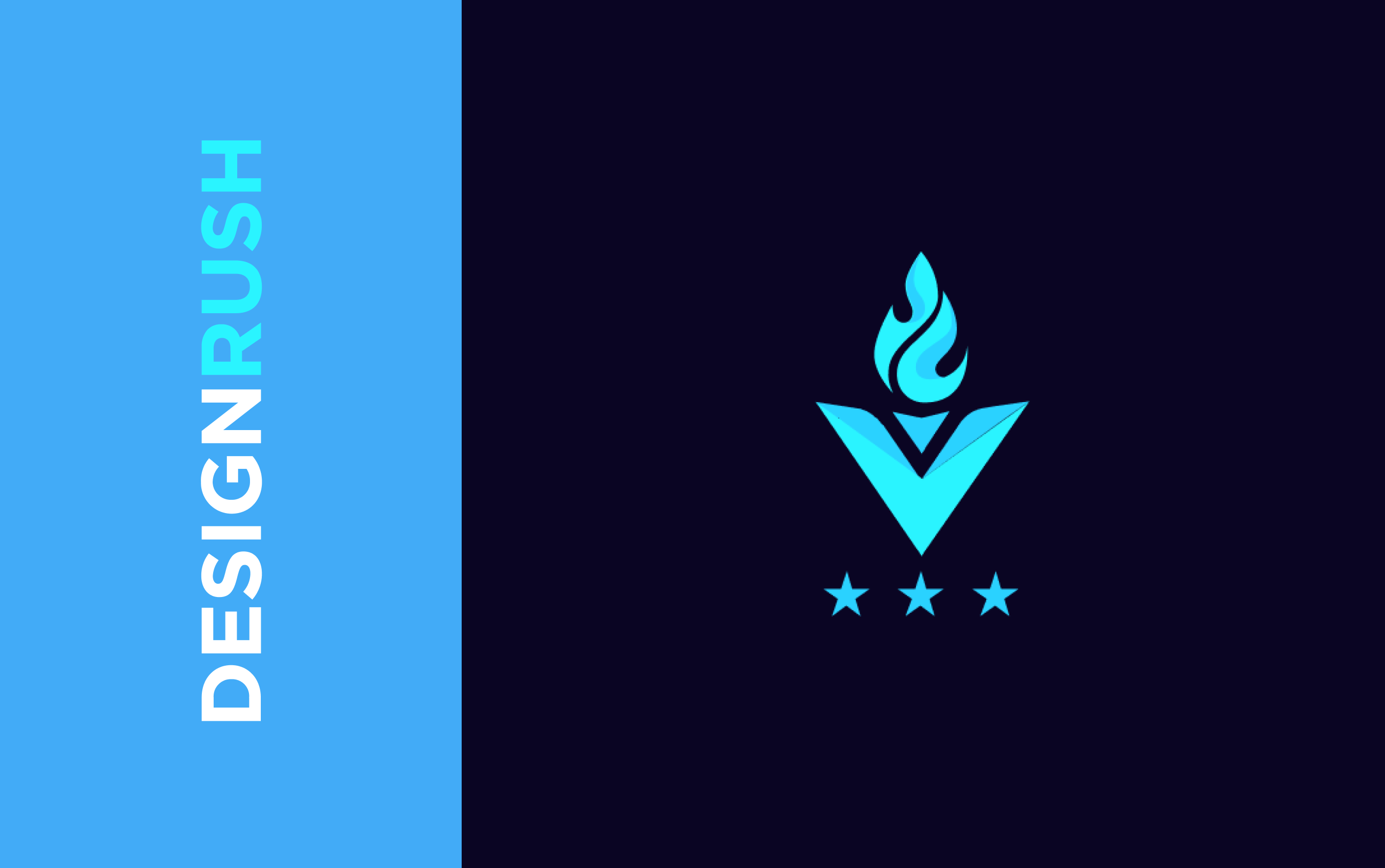People increasingly prefer online sports as it is cheaper, more convenient, and can be more varied. It started after the COVID-19 outbreak, which became devastating damage to brick-and-mortar gyms, franchises, and boutique fitness studios.
The almost $100 billion fitness industry has quickly shifted into a virtual world for those who have been able to adapt rapidly. However, those who haven’t implemented a digital strategy may not make it out alive, and if they do, they may never be able to recover fiscally.
In our previous article, we discussed everything about fitness apps. It is a very close topic to our today’s article. Read it to dive deeper and learn everything about this type of app. But today, we will talk only about home workout apps.

How to Create a Superb Fitness App Design
In an ever-changing world, businesses must adapt to different conditions. Failure dooms the company to failure and significant financial losses. If you own a fitness studio or gym, creating a workout tracking app is an excellent solution for establishing your business in the market.
The industry of home workout apps is expected to be worth $20.76 billion by 2028, growing at a rate of 23.5% each year. That’s impressive. So, if you decide to take your business to the next level and build your own workout app in addition to it, first, you need to understand this issue and comprehend how to implement this plan. Let’s break down this topic together.
Why are Workout Apps on Demand?
Movement is an integral part of human life. In a world where many people don’t take the time to go to the gym, the workout programming app is the only reasonable solution. The operation of such applications does not depend on the situation in the world, and they are available regardless of the time of day, unlike the halls. Similarly, your profit from creating such a workout reminder app will not depend on anything other than its quality and competitiveness in the market.

Dribbble shot by Axicube
Before you figure out what benefits your business will bring to creating a workout tracking app, you need to understand why this type of app is popular. Downloads of the most popular 35 workout apps the January of each year have grown 504.45% - going from 2.68 million downloads in 2017 to 16.2 million downloads in 2021.
-
Cost-saving
Let’s look at statistics. In the US, gym memberships cost $58 per month. But if we look at the average cost of the premium version of a workout programming app, the charge varies. Moreover, some workout apps are free or offer an acceptable price for personal workouts, while gyms require payment beforehand and a separate fee for a personal trainer.
Yet, it is a common practice when a workout tracking app has a free version with basic features that allow users to try it and then, if they want, upgrade it to a premium for a fee (this is the case for apps like Freeletics and Asana Rebel).
An average workout reminder app costs anything between $4.99 – $14.99 a month with some exceptions, like SWEAT which costs $19.99, and Nike Training Club, which is entirely free. To sum it up, let’s consider that 60% of Americans are so satisfied with their home workouts that they cancel their memberships.
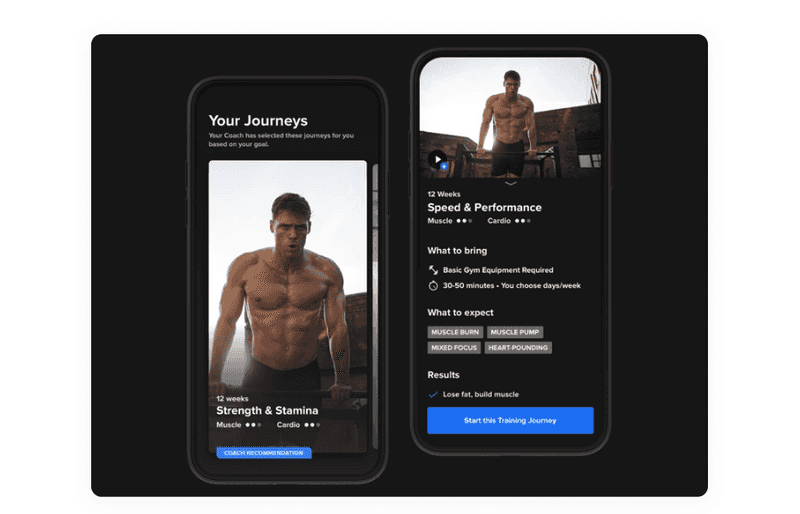
Screenshots from Freeletics
-
Easy to follow
A workout reminder app is easy to follow because it creates a personal program for the users based on their metrics. Yet, workout apps usually have huge libraries, so the users always have a wide choice of workouts.
Apps like Sworkit or Aaptiv have massive collections of workouts that fit different audience segments, like safe pregnancy workouts for moms-soon-to-be or even old routines for 50+.
-
Increased flexibility
A workout programming app is available anytime. Let’s say the user stayed late at work or went on vacation or a business trip - he can go in for sports literally at any time and in any place.
-
Advanced transparency
A workout reminder app can often connect to devices. Thus, users can track the number of calories burned, heart rate, and other indicators. As a result, it gives a better understanding of the workout’s effectiveness.
-
Ability to run workout diary
A workout programming app gives people the ability to track their workouts. For example, it is possible to note how many sets were done, how difficult it was, etc.
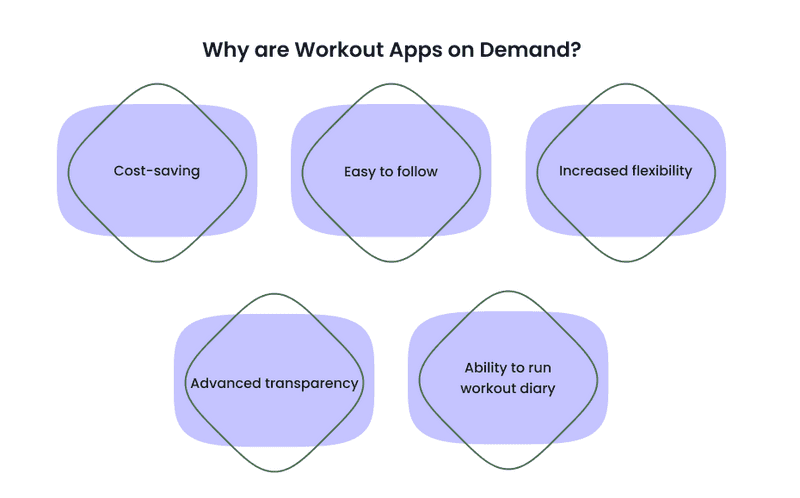
As you can see, workout apps have many advantages that make them more advantageous than gyms. And now, let’s figure out how creating an application for home workouts will help your business.
How Will Your Business Benefit From Building a Workout Programming App?
According to Statista, in the second quarter of 2020, health and fitness apps generated 656 million downloads. In the same quarter of the previous year, health and fitness apps were only downloaded 446 million times. The growth on an unprecedented scale has affected both businesses that were started as offline businesses (with Covid-19 as a catalyst for digitalization, forcing them to rethink how they can reach their members) and online from the very beginning (with Covid-19 as a growth accelerator).
Lauren Foundos, Founder & Chief Executive Officer at FORTË Fit, forecasts the future lies in a hybrid model: “I believe the future will be a blend of the two worlds. COVID-19 has forced many more people to try apps faster than they would have. And the overall opinion is favorable. This current situation sped up the evolution that was already happening. Studios need to create digital platforms, and users demand that from their favorite brands. A digital offering is no longer optional. It’s a must. Zoom, Instagram, and Facebook are great, free ways to connect to your community, but they are certainly not long-term solutions.”
Continuing its growth off of the pandemic, the workout, and fitness app industry will be worth approximately $5.85 billion in 2022. With the end of the pandemic, many have opted to stay with online workouts or combine them with going to the gym.
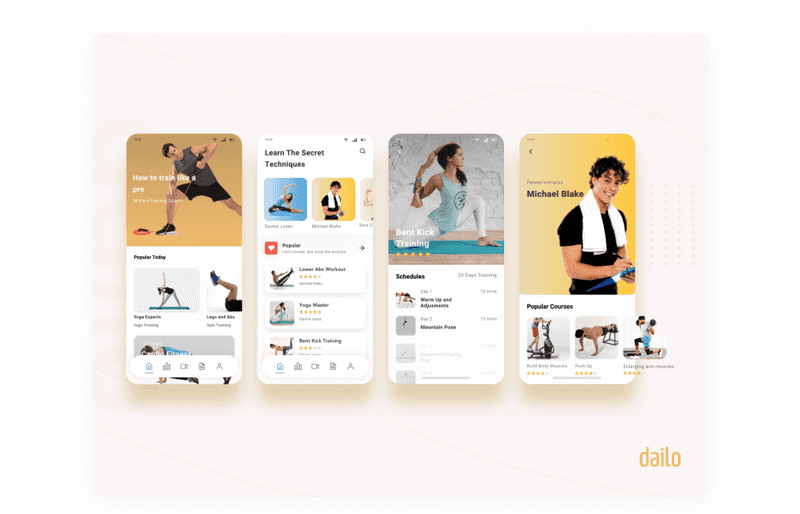
Dribbble shot by Salsabila Maurizka
Thus, when online training has become an integral part of many people’s lives and even replaces going to the gym for some, the question should no longer be whether to make a workout programming app. Instead, it is better to ask yourself when and how to make this app to strengthen the position and competitiveness of your business. But still, let’s look at the benefits you will get from building a workout tracking app.
-
Boost customer engagement
One way to maximize the potential of your remote user base is to create a workout tracking app with features that your online studio cannot offer. For example, you might consider implementing a sleep monitoring solution or meal plans. Or, if you want to be ahead of the curve, you might consider adding an AI module to your workout app (as long as it supports your business goals).
-
Improved customer experience
By combining in-app gamification and wearable device integration, you can achieve a new level of user experience. For example, users who opt for online training can integrate their wearables, share heart rate data, and stay connected with trainers virtually.
Thus, the user gets the experience as if he were in the studio’s walls. We are sure that your clients will appreciate it and recommend your studio and application to their friends and remain your regular visitors.
-
Alternative revenue source
Create your own workout app to get a new revenue source! With it, you can target not only those customers who stopped coming to your gym, but you can also access a much wider audience. Moreover, you won’t be limited to a particular location. Yet, you can profit from the workout tracking app’s monetization, which is one more pleasant reason to invest in it.
According to Beth McGroarty, president of research at the Global Wellness Institute, “The post-virus wellness future will be a ‘hybrid’ approach for many more people, with consumers making selective trips to gyms, fitness studios or businesses they trust, but otherwise keeping much of their activity online.” It only proves that investing in gym software is a good decision!
-
Open your business to a new user base
Make your own workout app to give your clients the option to workout at home or offline, depending on their preference. However, such an application allows your studio to find new clients among those you would not traditionally consider potential gym membership buyers. For example, think about the clients who live too far away from your gym and therefore don’t buy a membership.
You can target these potential users with a rewarding online experience. They are unlikely to be seen as regular visitors to your brick-and-mortar gym. However, they may participate in special offline activities such as workshops.

To summarize, once again, we would like to draw your attention to the fact that investing in the creation of a workout tracking app will help your business strengthen its position, increase its competitiveness, insure against a changing situation in the world, improve customer experience, become a new source of income, and also help to make itself known to a broader audience. These are strong enough arguments to decide on such a step, aren’t they? So, let’s now figure out what a workout reminder app is.
What is a Workout Programming App?
The concept behind the workout tracking app is to provide the user with a set of workouts. With the help of such an app, the user can learn new sports techniques or simply keep fit. In addition, the app can be connected to wearable devices to help track activity levels and calories burned.
Such applications are most useful for those who live too far from the nearest gym or simply do not want or do not have enough time to visit it. The most crucial thing in such an app is convenience and ease of use.
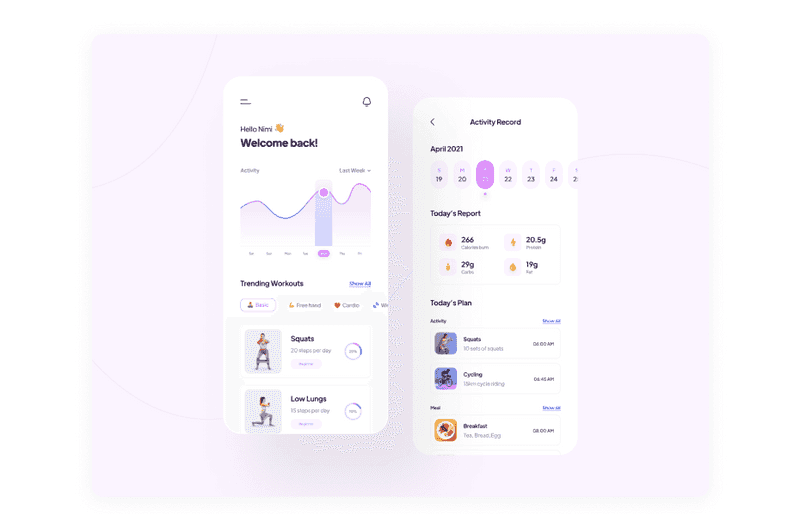
Dribbble shot by Piqo Design
The main focus of the workout reminder app is focused on workouts that are categorized by types, such as strength, endurance, and mobility. However, other filters include duration, level, intensity, and equipment. It makes it easier for users to find what they want. In addition, the training plans can be based on users’ needs and can be changed or adapted for different purposes.
Workout Competition App as a Subtype
There is an exciting subtype of workout apps like the workout competition app. Here the name speaks for itself. Workout competition apps work great, as even studies have found that working out with others helps motivate people, stay consistent, and set better goals.
So, what is the point? Workout competition app ’s main advantage is that it turns training into a game. When users complete workouts, reach levels and achieve challenges, they’ll be rewarded with points and unique banners. Yet, it is possible to people to compare their results with the others or invite friends to complete challenges together.
Workout competition apps can have different concepts. For example, Fitfully provides users with live video chat workouts with friends. The user can set a training routine and invite friends to make it together by video call. Or another workout competition app like FitFriendzy offers workout challenges from easy to hard and allows users to join with others and invite friends to participate. Rather than competing against others, the users will cheer each other.
So, as you see the workout competition apps have a lot of potential. You can add any activity there and turn it into a competition. But let’s return to our main topic.
What is the Difference Between a Workout Tracking App and a Fitness App?
Workout and fitness apps sound like they’re pretty much the same thing, but they’re not. A fitness app is a broader concept, while a workout reminder app is a narrower subtype. The purpose of the fitness app is to track the user’s activity and provide health recommendations.
To tell a long story short, a fitness app has some unique features. These apps allow users to control and manage gym equipment, recommend the best diets, enhance exercise plans, and track personal fitness activity. In addition, they provide health recommendations and help the user gather additional information for health assessments like steps and distance covered, number of calories consumed or burnt, etc.

Dribbble shot by Cuberto
While the workout tracking app focuses mainly on workouts, it is also imperative for such an app to show exactly how to perform the exercises. Otherwise, the activities may cause injury or not give the desired effect. Usually, a personal trainer at the gym makes sure people do their exercises correctly. Still, with these apps, users no longer need to pay for the gym - 3D models, videos, or just detailed descriptions explain how to do each workout.
In the fitness app, the user sees his activity indicators and what health recommendations they can apply, and in the workout reminder app, the user directly trains. After this distinction, we suggest that you familiarize yourself with the main features of the workout tracking app.
Key Features to Build a Workout App
If you want to create a workout app that will be successful, you need to know an essential list of features. These will satisfy your users and make your workout tracking app helpful and pleasant.
-
Quick sign up and profile creation
It is a primary feature for almost every type of app. Provide users with a quick sign-up via socials, email addresses, or phone numbers. People don’t like when it is too many things to fill up to sign-up for the app.
-
User profile
It is where users personalize their experience by entering weight, height, activity level, and more. With these measures, it will be possible to provide users with correct goals and suggestions.
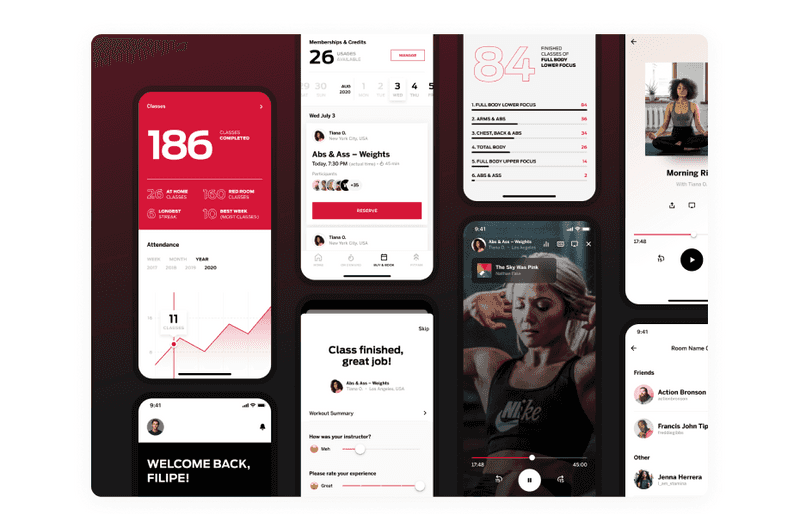
Dribbble shot by Adam Roller
-
Goal setting
People start playing sports and download workout tracking app accordingly for various reasons. For example, someone wants to gain muscle mass, someone wants to lose extra pounds, and someone just wants to keep their daily activity regular. It is essential to allow users to choose their goals because, depending on them, it will be much easier to select a training plan for them.
-
Workout plan
This feature will guide the user toward their goals. It will also be helpful for beginners who do not know where to start—offer users workout plans based on their goals, weight, and activity.
-
Workout library
Your workout reminder app must have a library of workouts. Perhaps the user does not want to follow a strictly scheduled program or wants to try something new. In this case, the library will be a great feature.
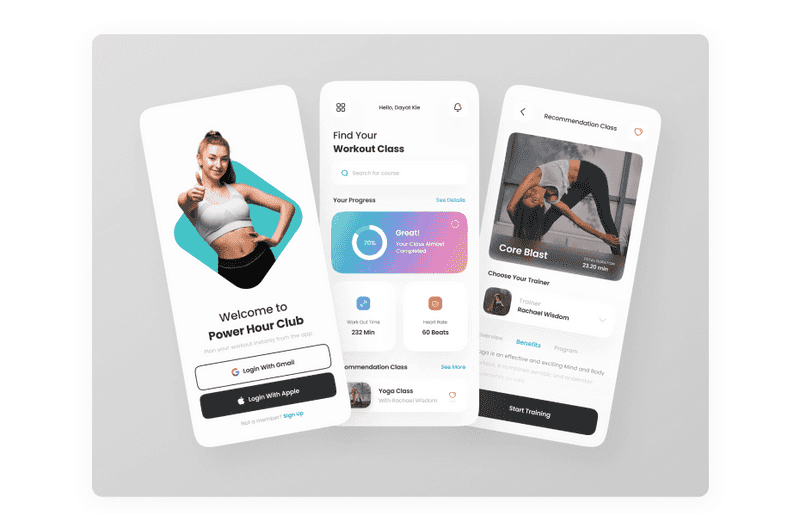
Dribbble shot by One Week Wonders
-
Categories
Provide users with different filters within the library. Not all users are the same in terms of fitness. Someone can be an expert and someone a beginner. To satisfy all categories of users, you must provide them with a function that allows them to find the right program depending on their level and type.
Categories should consist of filters such as most popular, workouts for beginners and advanced, nutrition, no equipment, weight loss, strength and muscle, cardio, yoga, dance, short workouts, rest and recovery, and low intensity.
-
Video tutorial
Video tutorials will best show users how to do the exercises correctly so they won’t harm themselves and that the workout will be effective.
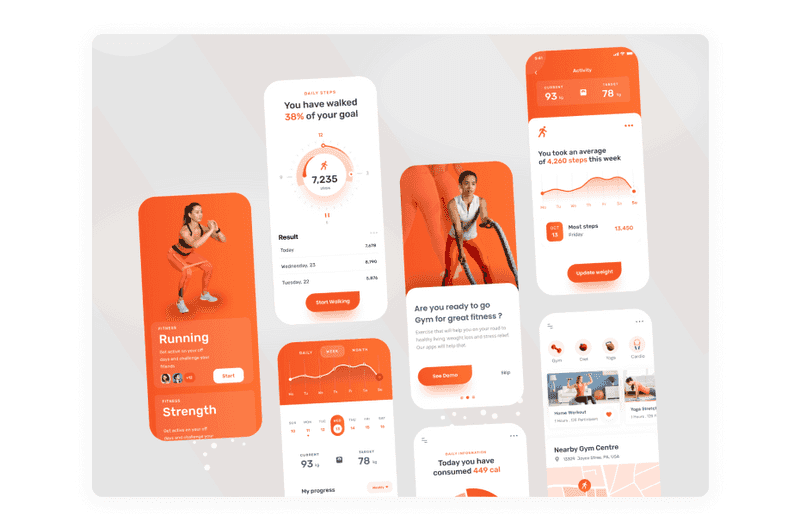
Dribbble shot by SylGraph
-
Search
No matter how many shortcuts your workout tracking app has, users, will always want a search button because it makes the app easier to use. This feature will allow users to quickly access categories such as programs, fitness videos, and more. In addition, with the added filters, users can further refine their search.
-
Progress tracking
This feature will allow users to view their goals, track their activity, overall results, and charts showing their growth. In addition, let users filter their data range by date or activity.
-
Activity reports
Activity reports will give users a clear understanding of how their workout went and how many calories they burned. It will serve as an introductory function and as an additional motivation.

Dribbble shot by Andersen Design
-
User dashboard
The home tab allows the user to see all their needs in one place. This feature will serve as a link to all other features. Users can access their current program from where they left it before, access their activity log via shortcuts, and start exercising right away.
-
Stopwatch
In addition to each exercise, add a stopwatch to the screen. Thus, the user will understand how long he has been doing the training and will connect the excitement to hold out more than the last time.
-
Accessibility support
Accessibility support is needed not only for users with disabilities but also for others. For example, imagine a moment when you sweat a lot. It’s not so easy to hit the button, is it? Make enlarged and visible buttons on the workout screen to prevent such difficulties.
Also, to increase accessibility, you can implement a screen reader in your workout reminder app. Thus, people with visual impairments will also be able to play sports while enjoying your application. And to learn more about accessibility and how it affects your business, read our previous article.

Accessibility Design Matters: Why is it So Important?
-
Notifications and reminders
With the help of notifications, you can communicate with your users: inform them about new workouts in the library or about a new update that has been released. Reminders can work great for users who haven’t logged into your workout tracking app in a while. Remind them of you! Reminders will also help users achieve regular sports activities.
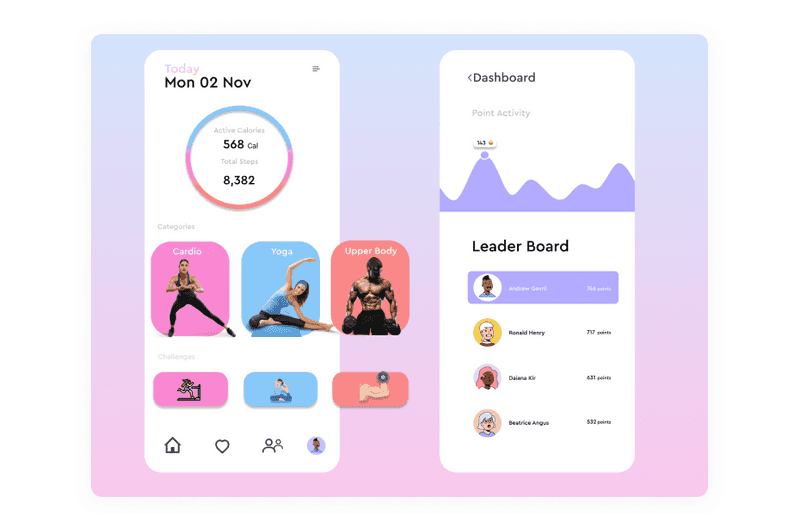
Dribbble shot by Gasper
-
Settings
This is an essential and mandatory feature for any application. Here the user can set the application’s language, view the privacy policy, change their login information, etc.
-
Payment gateway
This feature in your workout programming app is needed so that users can make secure payments according to your monetization model.
At this stage, we got acquainted with the main features of the workout tracking app. With them, your app will be as profitable and convenient as possible. This means you can achieve your business goals. But we must remember that there are many similar things in the app market.
To somehow stand out, you need to develop something that can surprise and lure a whimsical consumer. Additional features will help with this, which will make your workout reminder app stand out more.
Extra Features to Make Your Workout Programming App Outstanding
The workout app market is overflowing with offers. But how to build a workout app that would stand out more? The extra features can help with it. They will add uniqueness and value to your workout tracking app. Let’s look at some of them:
-
Live streaming or video-on-demand
Your workout app can also become an online workout platform. Thus, coaches and athletes will be able to connect and perform exercises in real-time via live broadcast. Therefore, you will increase engagement and ensure the influx of new users. Indeed coaches have their audience.
-
Workout diary
With this feature, the user can leave notes about the completed workout. In addition, you can allow evaluating feelings after it and the complexity by using the tags.
-
Diet plan
Adding a diet plan to your workout tracking app is a great idea! Thus, users will achieve their goals faster, and your application will be more valuable to them. It can become both the primary function and a premium subscription feature.
-
Barcode scanner
With this feature, the user will not need to search for a product in a long list or enter the name manually. Instead, they can simply scan the barcode through their phone’s camera and find the right product.
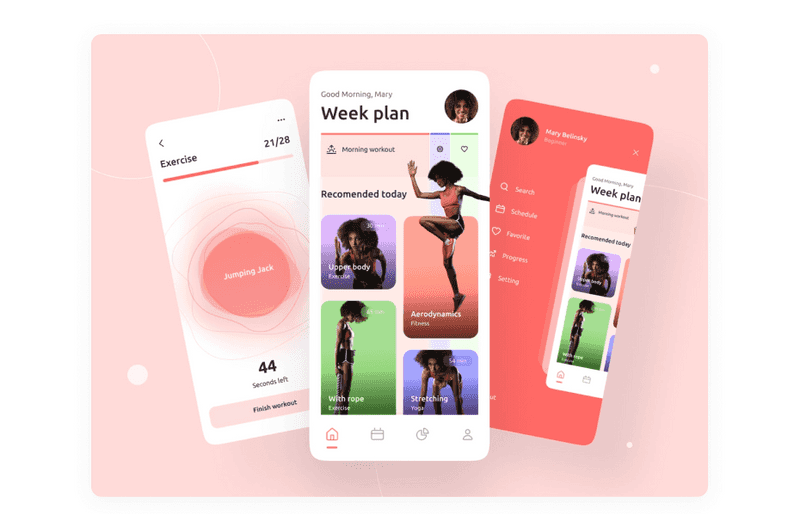
Dribbble shot by Ronas IT | UI/UX Team
-
Calorie counter
In the workout tracking app, calorie counting will be needed to show users how many calories they are burning during a workout. A calorie counter can also work to keep track of how many calories they have consumed in food.
-
Recipes
To make it easier for users to stick to and achieve their goals, provide them with exciting and valuable recipes. It will increase engagement.
-
Wearable and non-wearable device integration
Wearable device integration is always beneficial. Millions of people rely on these devices today, and forecasts suggest that user spending on wearables will exceed $90 billion by 2022. As a result, workout apps integrated with wearable devices have increased value. It also encourages users to use the app more often.
-
Deep heart monitoring
With this feature, users will be able to monitor their heart rate and pulse during workouts. Many workouts are effective at a specific heart rate, so this is important.
-
Machine vision and motion detection
Using the smartphone’s camera, the application with machine vision and motion detection analyzes the body’s position, provides real-time instructions, and tracks the exercise.
This feature will make it easier for your users to achieve success, as they are more likely to perform the activities correctly. And if they achieve their goals with your workout tracking app, they will recommend it to their friends.
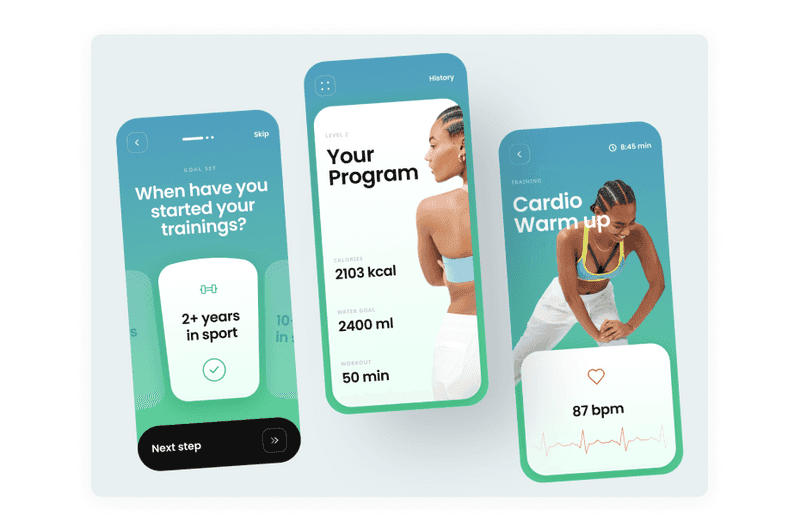
Dribbble shot by SELECTO
-
Hands-off capabilities
Most exercises are impossible to do when you constantly hold your smartphone. Wearable device integration can help here. Let users control the workout from a wearable device.
-
Optional audio support
It is not always convenient to constantly look at the phone screen to understand which exercise is next during a workout. To avoid such inconvenience, allow users to turn on an audio voiceover that will sound the next exercise and give a short description.
-
Multi-device synchronization
It is very convenient for those who simultaneously use both a phone and a tablet. There will be no problems using the workout reminder app from different devices with this feature. The user will be able to enter the application and be where they left off.
-
Offline mode
Build your workout app that can be used online. For example, you can allow downloading some workouts. Thus, if the user decides to go on vacation to a place where the Internet connection is poor, he will still be able to enjoy your workout tracking app.
-
Online consultation & chat
Users can buy online consultations with trainers or receive them on a paid subscription with this feature. It will help advanced users who want to ensure that the exercises are performed correctly and beginners who need advice from a specialist. Here you can also make a chatbot that can answer basic questions.
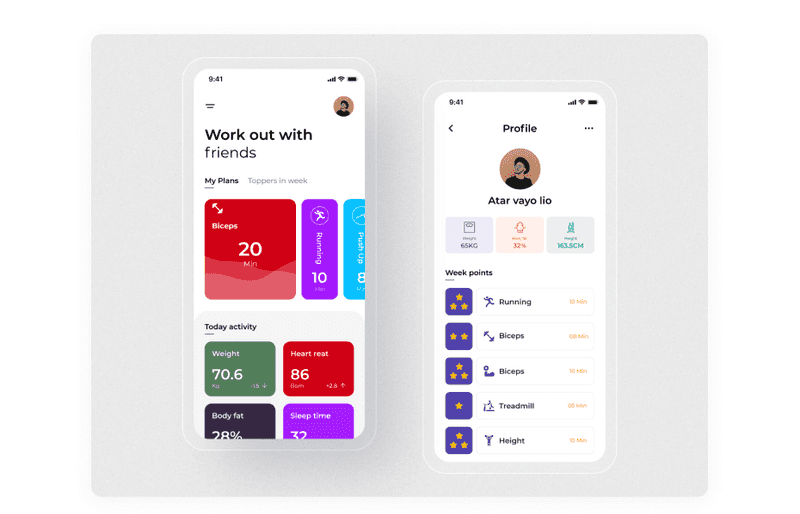
Dribbble shot by Amirul islam
-
Educational content
Here you can post helpful articles and tips from expert trainers. It will increase users’ engagement, as they will be interested in insights on workouts and getting themselves into the desired shape.
To get more exposure and publicity for your business, you can even create a YouTube vlog, make short videos about workouts, healthy eating, healthy living, and more, and upload them to the app.
-
Newsfeed
Users can post, comment, reply, and encourage other fitness enthusiasts with this feature. App users should be able to track and share activities in the app. Ensure this newsfeed works on all devices and that every user can access it.
-
Social sharing
Social networks are an integral part of our life. Therefore, integration with them is essential. Let users share their success on different socials.
-
Gamification
Gamification is when you apply game-like features to a non-game app to make it more fun and engaging. Yet, you can add a leader board to play on people’s sense of competition. It will be fun and motivating.
MVP features are necessary, but they won’t improve your application as every app has these features. After reviewing the complete list of features, you can move on to more specific actions or steps.
Steps to Create Your Own Workout App
After learning what a workout tracking app is, what it is for, and how it will help your business, you most likely want to move on to the specifics. So, how to create a workout app? First, you need to know that the design process has a stable structure. Then, if you want to know more about it, read our previous article.

How Do the Perfect Design Process Steps Look? Everything You Need to Know
Here we will give you a short overview of how to make a workout app. With this, you will know what steps you’ll have to take toward the perfect workout tracking app for your business.
Step 1: Market Research
Market research is an essential step toward identifying your target audience. It will show what your competitors offer users, their shortcomings, and where they have been successful. By studying the pain points of your competitors, you will get an idea of what kind of workout reminder app you need to make to gain more user attention.
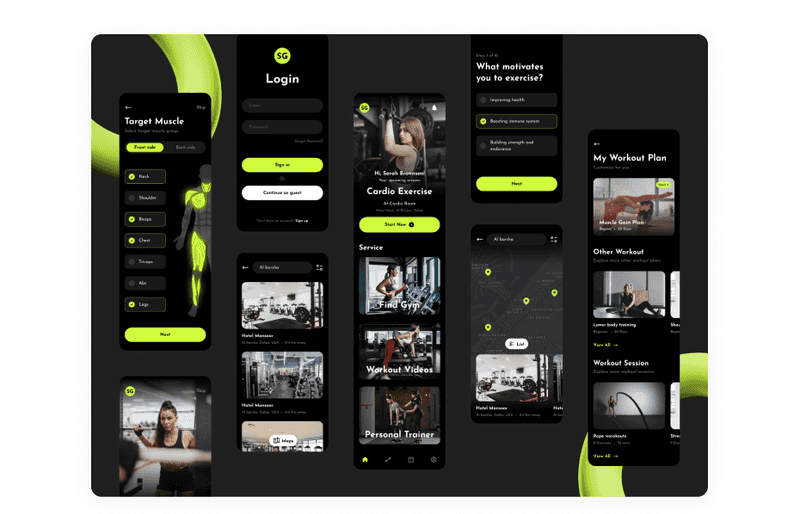
Dribbble shot by Maccario Lab
In addition to learning about your competitor’s product, you should also know how they target users. It ranges from how they work on social media to the user experience provided within the workout tracking app.
You can also find popular street workout apps in the App Store or Google Play. Sort apps into categories and learn everything about these apps - features, functionality, design, premium subscription prices, etc. But, first, you have to figure out why each app is widespread and the main reasons people use it.
Once you’ve researched your competitors, their strategy, and products, it’s time to research your audience. Who will you create own workout app for?
Step 2: Know Your Audience
Market and competitor research can help you identify your target audience, which is a group defined by demographics and interests. Recall that creating a workout reminder app allows you to open new audience segments for your business.
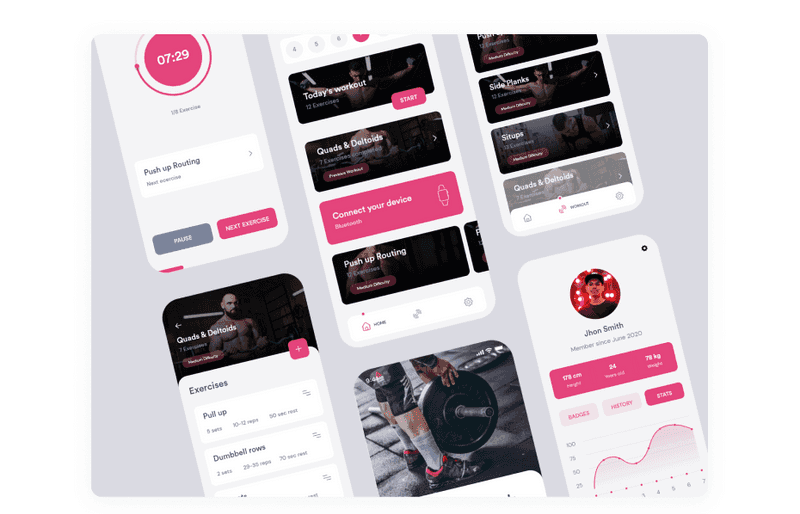
Dribbble shot by SabbirMc
To define your audience, you first need to do data analysis of your business’s existing audience and then do another study to understand what other audience you can reach with the workout tracking app. In our previous article, we’ve discussed the research methods that can help you to define your audience perfectly. Read it if you want to know everything about it.

Essential UX Research Methods For Your Business
Once you’ve broken down the market for existing workout apps, your competitors’ strategies, and defined your target audience, you can move on to the next step.
Step 3: Define MVP
MVP stands for “minimum viable product.” The main idea of an MVP is that it is the base version of a new product that allows product teams to collect the maximum amount of feedback and verified customer information with the least amount of effort.
The idea is to produce a real-life-like product as quickly as possible to offer it to customers. You can then observe actual customer behavior, which is more reliable than asking people what they would do.
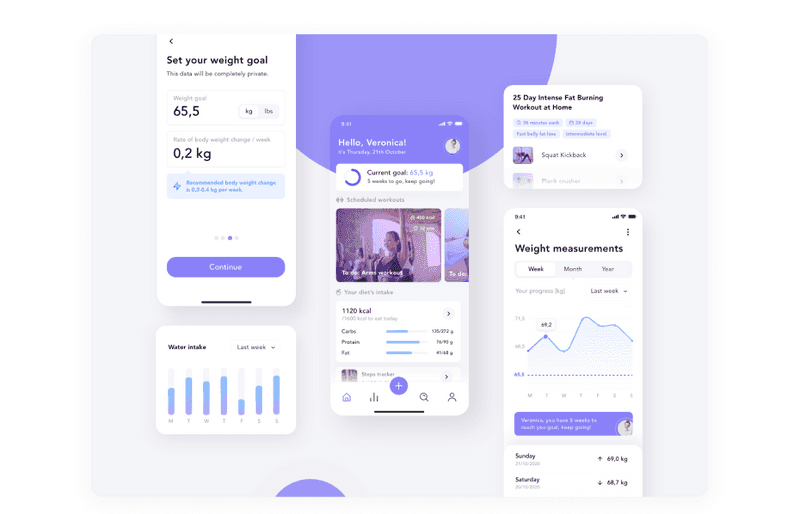
Dribbble shot by Miquido
After MVP testing, you will understand your idea’s success and whether your workout tracking app will be in demand. If the test results were disappointing, it doesn’t matter, just rethink the concept, review again how well you defined the audience, and repeat this step. And if you are satisfied with the user survey results, you can move on to the next step.
Step 4: Create Wireframes and Prototypes
In our previous article, we analyzed in detail why this step in the design process is needed. If you want to know more about this, be sure to read our article. And here, we need to outline the main thing: wireframes are the skeleton of your future application, which is necessary to sort content and prioritize it. After this step, you can start prototyping.

What is a Wireframe and Why Do You Need it in the Design Process
Prototypes are like level-upped wireframes. They are more detailed versions of the future app. An interactive and workable prototype design gives users a realistic view of the final product. They are created to be able to test them on real users. This way, it will be possible to collect feedback before the launch. It is precious because it will save you money! It is much easier and cheaper to fix something during the prototyping or design phase than when the product is already in production.
Step 5: Beautify it!
The workout tracking app should have a simple but crowd-pleasing design. Do not overload the design with too many elements and effects. The user should quickly find the workout or activity statistics they need. Animations and game elements are always welcome in the workout reminder app.

Dribbble shot by Merixstudio
Most often, for the design of such apps, they prefer to use a minimalist style. This way, the design will be clean, good-looking, and not distracting. So choose a limited color palette that is pleasing to the eye, organize all the elements and navigation beautifully, and end up with beauty.
In our previous article, we discussed how to make a beautiful and, at the same time, sell design. Read this article to apply some tips to your workout tracking app. If you stick to the design principles, your workout app will turn into a work of art.

Take My Money: Visual Design vs UI Design as a Method to Make Selling Product
Step 6: Establish Your Marketing Strategy
After a great design is done and your workout tracking app is in development, it’s time to think about the marketing strategy. Think about promoting your app and how you will do it after release. Use social media channels to announce your app and describe its features and capabilities.
You can hire a content writer and PR manager to take your promotion to the next level for a more effective result. You can also partner with fitness influencers who promote your app to their audience. In addition, it can be a part of the monetization strategy, so you will both promote your workout tracking app and get a profit from it.
How much does it cost to build a workout app?
Now, let’s assume how much money you will need to invest in the design of the workout tracking app. This question is complex and needs clarification. The fact is that the cost of creating a workout application depends on its complexity; (design features, number of features, location of the design team).
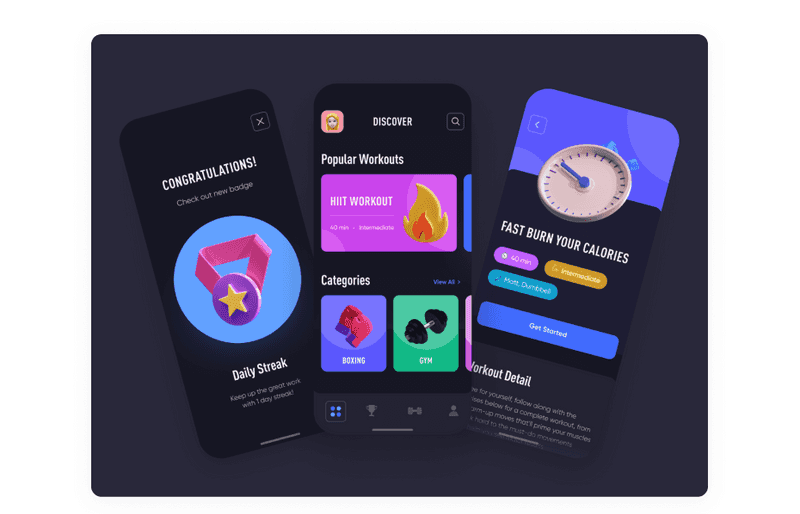
Dribbble shot by Victoria Samoilenko
And location will play a significant role in app design evaluation. We think you already know that each region has different hourly rates; it has to do with market conditions. Thus, North America (the USA and Canada) offers a $55 - $85 per hour. In contrast, a neighboring region (South America) provides rates within the $30 - $45 range.
The European continent offers the same range difference. For example, central Europe’s rate varies between $40 and $80. But Eastern European countries like Ukraine, Poland, Bulgaria, etc., charge about $30 - $55 per hour.
Axicube is located in Ukraine. Does low hourly rates mean poor design? Fortunately, no. Ukrainian companies are well known for their high and reliable design skills and large projects. If you choose a Ukrainian company as an outsourcing team for your project, you will not waste your money.
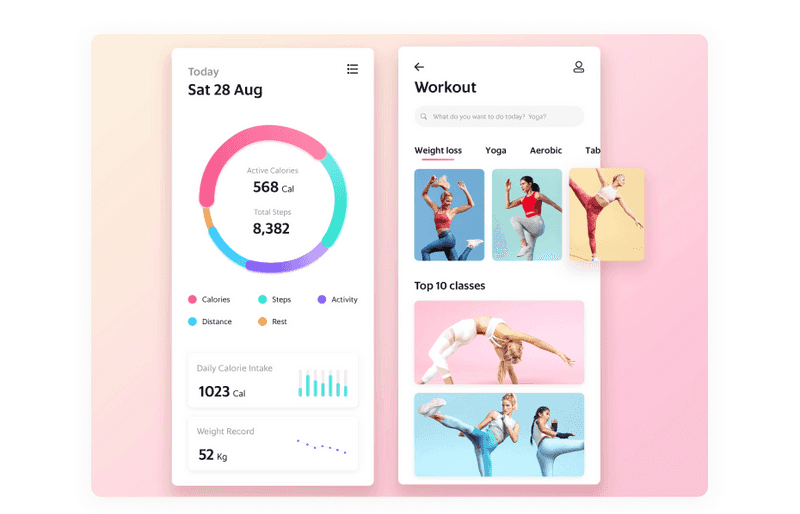
Dribbble shot by RED
At Axicube, we take ~$40 per hour. But the value can’t be predicted until you send us all your requirements. Hourly rates may also depend on the complexity of the project and ideas. On average, work on an app design takes 140-200 hours. But again, this can vary depending on its complexness. Our activities during this time will include:
- Discovery and UX research ~ 30-50 h;
- UX Design ~ 40-50h;
- UI Design ~ 70-100h;
- Additional materials: animation, illustration, testing, etc.
After we’ve talked about the investment to make in a workout app, let’s find out how to profit from it.
Get a Profit: Monetization Strategies for a Workout Tracking App
If you create a workout app to complement your fitness studio or gym, you will win and get more clients anyway. But what else is good about making a workout programming app? This is, of course, monetization. Thus, you can earn even more from it, and it will be a long-term prospect. Let’s see what options do you have:
-
In-app purchases
A great option if you want to provide a free workout reminder app while making some profit. Users can buy personal training, healthy food recipes, video tutorials, etc. Of course, it all depends on what features you fill your workout tracking app with.
-
Premium subscription
This means that the workout tracking app is free, but it has limited functions. And if the user wants to unlock the rest of the features, they must buy a premium. It can be an annual, monthly, or weekly subscription.
-
Advertising
With this monetization model, you can advertise workout-related equipment, stores, or blogs and receive some kind of fixed payment for it. But be careful: your app should not be too full of advertisements. Otherwise, users will not want to use your workout tracking app.
-
Referral program
People are more likely to trust the recommendations of their friends than advertising. Statistics have even proved it. According to Hubspot, 75% don’t believe in advertising, but as many as 90% trust recommendations from friends and family.
With the referral program, you can allow your most interested users to invite friends to your workout reminder app with whom they want to train. Thus you will have a growing community of actively engaged users. Here you can add some kind of bonuses or gamification. For example, if a user invites a friend, they will receive a set of paid workouts.
-
Affiliate program
Affiliate programs are about leveraging the authority of influencers to bring new customers to your workout tracking app. As a result, they help you expand your customer base and increase revenue. But that is not all. An influencer’s recommendation increases loyalty to your product, as they are generally trusted.
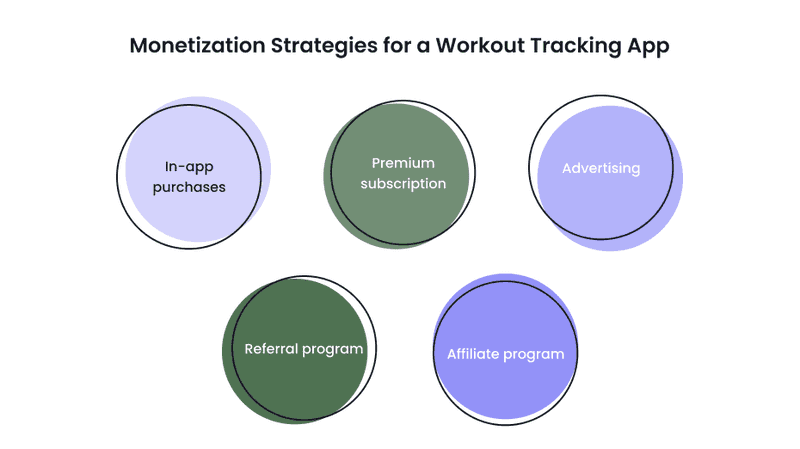
You can choose not one monetization model but even two. The main thing is that they are well combined.
Challenges of Creating a Workout Tracking App
The workout app development process has some challenges. However, if you choose expert people to work on it, you will be able to overcome these challenges effectively without compromising the features and functionality of the app.
-
Data security and privacy protection
Data from workout apps, especially those integrated with wearable devices, can be a tidbit for hackers. In addition, this data can be sold to third parties for phishing attacks on the user. Therefore, you must take steps to protect user data and their privacy. To avoid information leakage, end-to-end data encryption can be integrated to ensure that any unauthorized person does not gain access to user data.
-
Wearables integration
Integrating the workout tracking app with various wearable devices and equipment is necessary to get more engagement from users and accurate results. Fortunately, most wearables have a set of APIs and SDKs (software development kits) that allow third-party app developers to integrate them into apps.
-
Regular updates
Ever-changing requirements, ever-increasing expectations, and intensifying competition force app owners to update their apps regularly. Regular updates are essential to keep users on the app for a long time. As an entrepreneur, you need to have a specific budget for regularly releasing premium app versions to stay ahead of the curve.

Dribbble shot by Outcrowd
Here, we’ve covered some of the main challenges of developing workout apps. We hope this will clarify the main points worth paying particular attention to.
Conclusion
If you decide to create a workout app and your existing business, this is a great idea. This solution will help your business be more sustainable in the world’s changing conditions, find new customers, and become more competitive.
Designing a home workout tracking app can sometimes be tricky due to the extra features. However, your application can succeed if you ensure that your project contains relevant features that add value to users.
This path is not without challenges, as you will need to take care of protecting personal information and how to keep your application up to date, but the pros of this venture indeed prevail.
At Axicube, we have good experience creating various applications for various companies and startups. Our expertise also includes the creation of a fitness application. Our team will help you go through this path easily and without problems.

